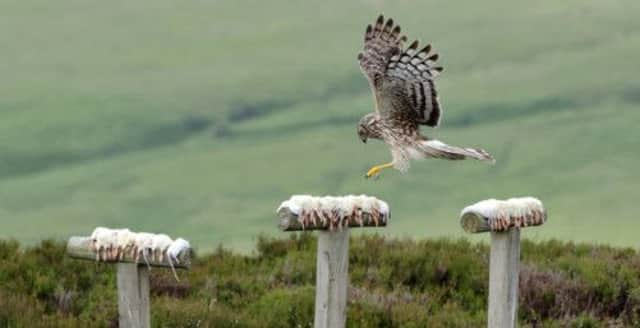New study shines light on hen harrier


But a groundbreaking new study has found that the hen harrier can live in harmony with the game bird that brings millions of pounds into the Scottish economy.
Research by scientists at the Game and Wildlife Conservation Trust reveals that gamekeepers can manage moorland in a way that allows both the grouse and the birds of prey to co-exist.
Advertisement
Hide AdAdvertisement
Hide AdThe findings, released in advance of the Glorious 12th of August when the grouse- shooting season begins, may help to reduce the numbers of hen harriers that conservation groups claim are illegally killed every year in rural Scotland to help protect valuable grouse stocks.
The work, conducted at a project on Langholm Moor in southwest Scotland, found that if gamekeepers control other predators, such as foxes and crows, numbers of both grouse and harriers – both ground-nesting species – rise. Then if the harriers, themselves a protected species, are artificially fed at key times for their own chicks, they stop preying on the young game birds.
Dr David Baines, the author of the study and the Trust’s director of upland research, said: “For many people it will be quite astonishing because they are always reading headlines about how grouse, hen harriers and gamekeepers don’t go together. But we have shown that on this occasion they can.
“When predators were controlled, harriers were doing a bit too well and predation levels on grouse became so much that shooting [of grouse] stopped.
“So at key times, such as when harriers have chicks to feed, we provided supplementary food in the form of dead rats and day-old poultry chicks on feeding posts. The harriers took that with very few bringing back grouse chicks instead, so this does seem to be a reasonable way of stopping harriers preying on grouse.
“We would encourage all grouse moors to take up this method to see how it works for them. We can’t go on in the way that we have, there has to be a compromise.”
The study – to be published later this year in the Journal of Applied Ecology – recorded that while gamekeepers controlled predators on the moorland, the number of hen harriers rocketed over a five-year period from two breeding females to 20 breeding females. At that point the number of harriers preying on grouse had a significant impact on numbers of game birds on the moor.
But predation dropped significantly when dead white rats and day-old poultry chicks were put out near harrier nests on one part of the moor to see whether feeding the birds of prey could reduce the numbers of red grouse killed. The Scottish Gamekeepers Association said it would also support wide use of what is known as “diversionary feeding” to see how effective it is on other grouse moors.
Advertisement
Hide AdAdvertisement
Hide Ad“The scientific research work at Langholm is vital and has proved what many land managers working every day in the countryside have known for some time,” a spokesman said. “Game management, with grouse shooting providing the economic driver to carry on all the associated habitat and predator control work, provides a suite of conservation benefits for grouse and harriers.
“With the research having established that part, the next part is to put the techniques in place to reduce the impact of harriers on grouse, thereby reducing the conflicts. There is still some distance to travel here. Diversionary feeding, for example, has been shown to work when harrier numbers are at fairly low densities.”
Hen harriers are renowned as the most persecuted birds of prey in the UK because they eat young grouse. Fewer than 700 pairs remain in the wild in the UK, most in Scotland. But, according to scientific studies carried out for the environmental charity the RSPB, they are conspicuous by their absence on grouse moors which should be prime habitat.
Animal rights group OneKind said: “Diversionary feeding is said to be a promising means of reducing the conflict between conservation of hen harriers and management of moors for grouse shooting.
“Obviously we don’t support or promote sport shooting but as long as that is the primary economic use of the land we would support diversionary feeding as a non-lethal technique. We need to remember, though, that it is simply illegal to kill hen harriers regardless of whether alternative methods are available.
“Successful implementation of these measures on grouse moors may diminish the perceived necessity by many grouse moor managers to illegally kill harriers to protect grouse stocks and render the legal control of generalist predators by gamekeepers a more acceptable technique for conserving ground-nesting birds including harriers.”